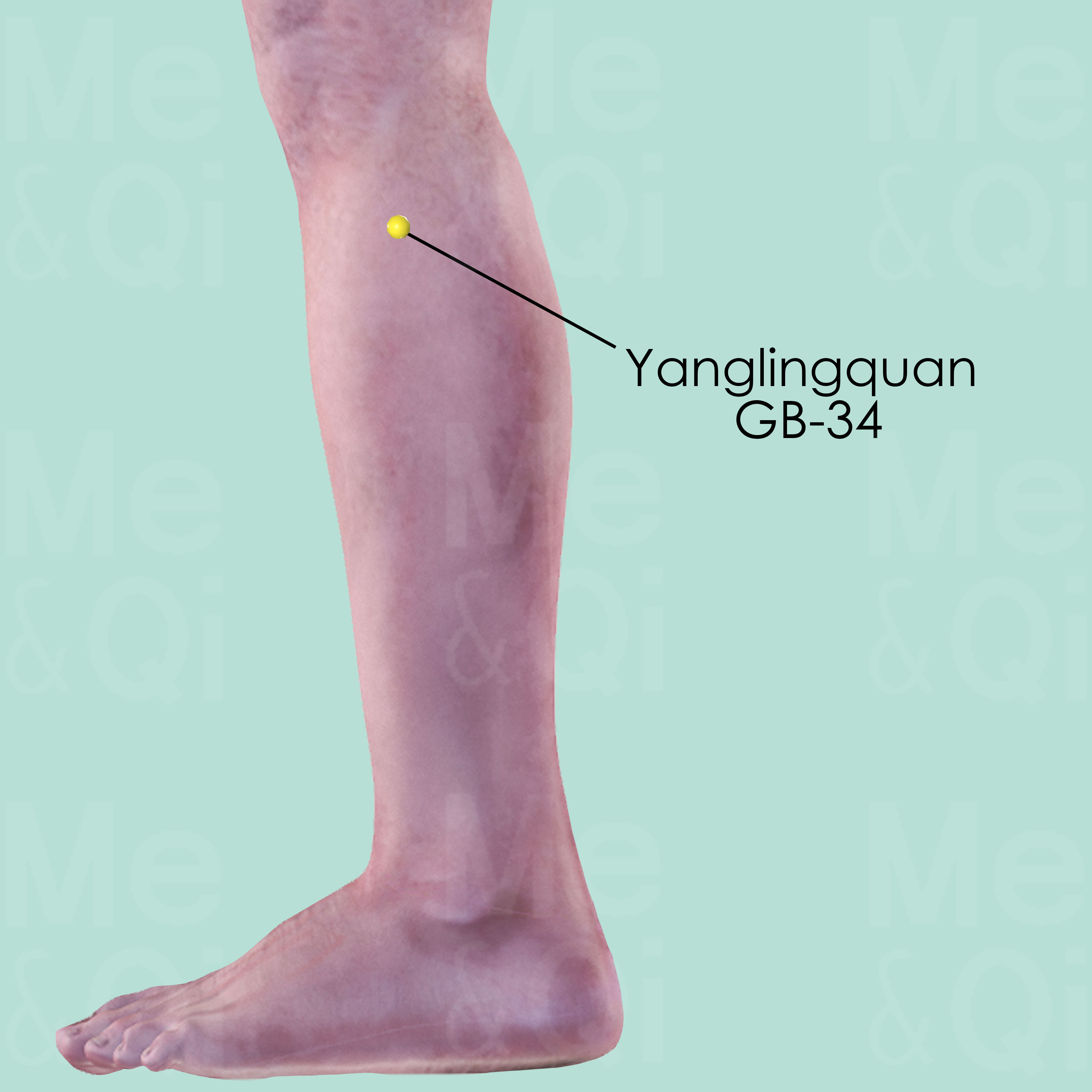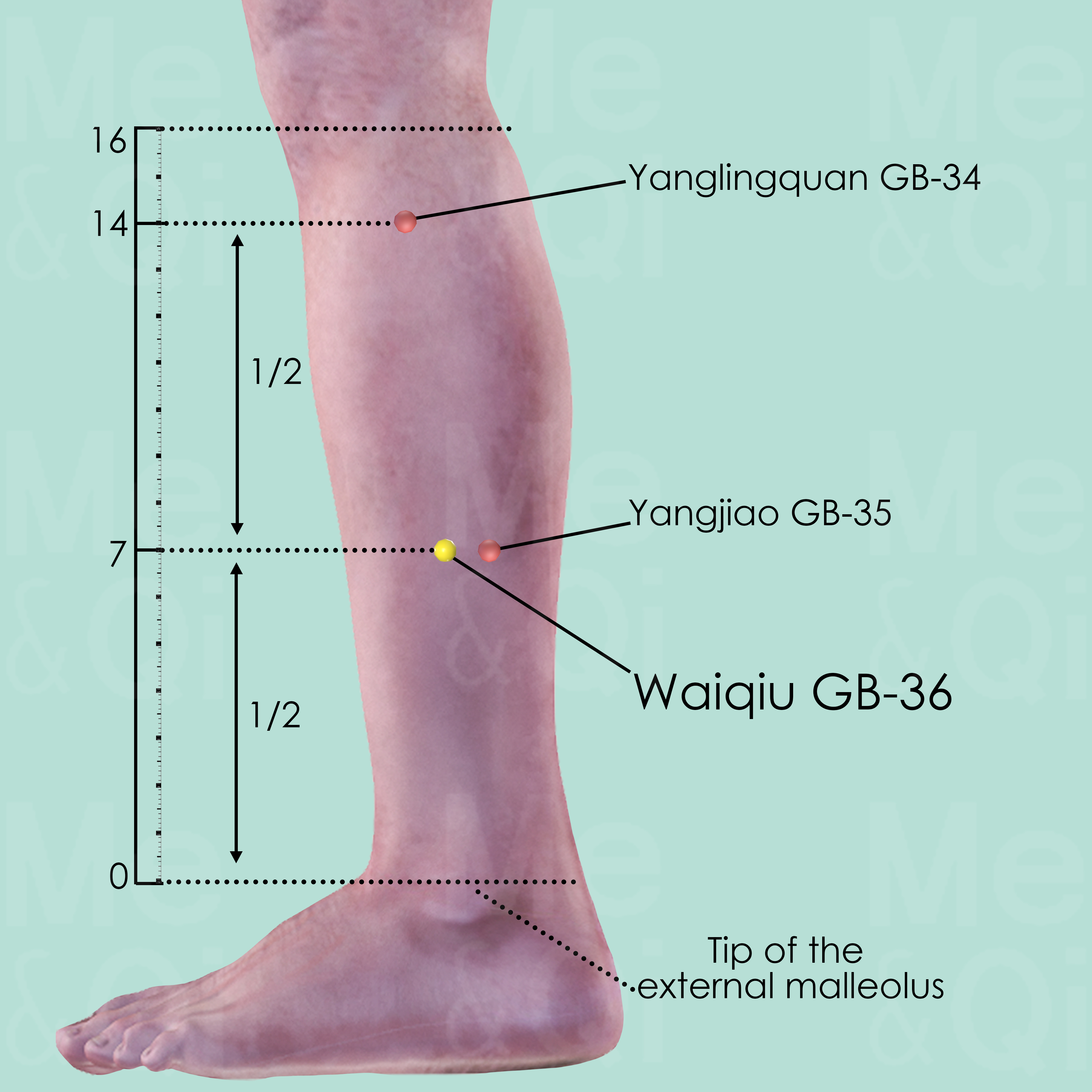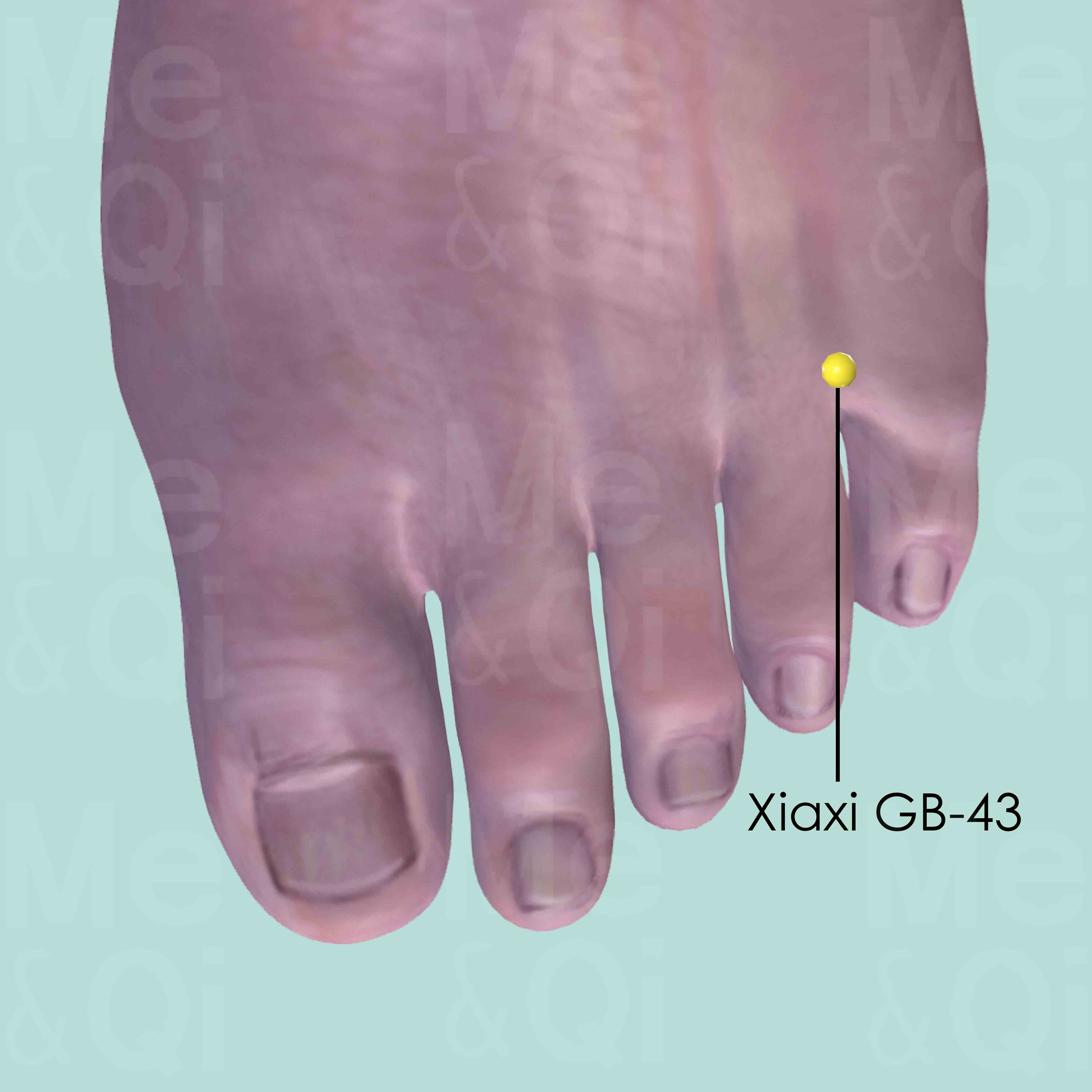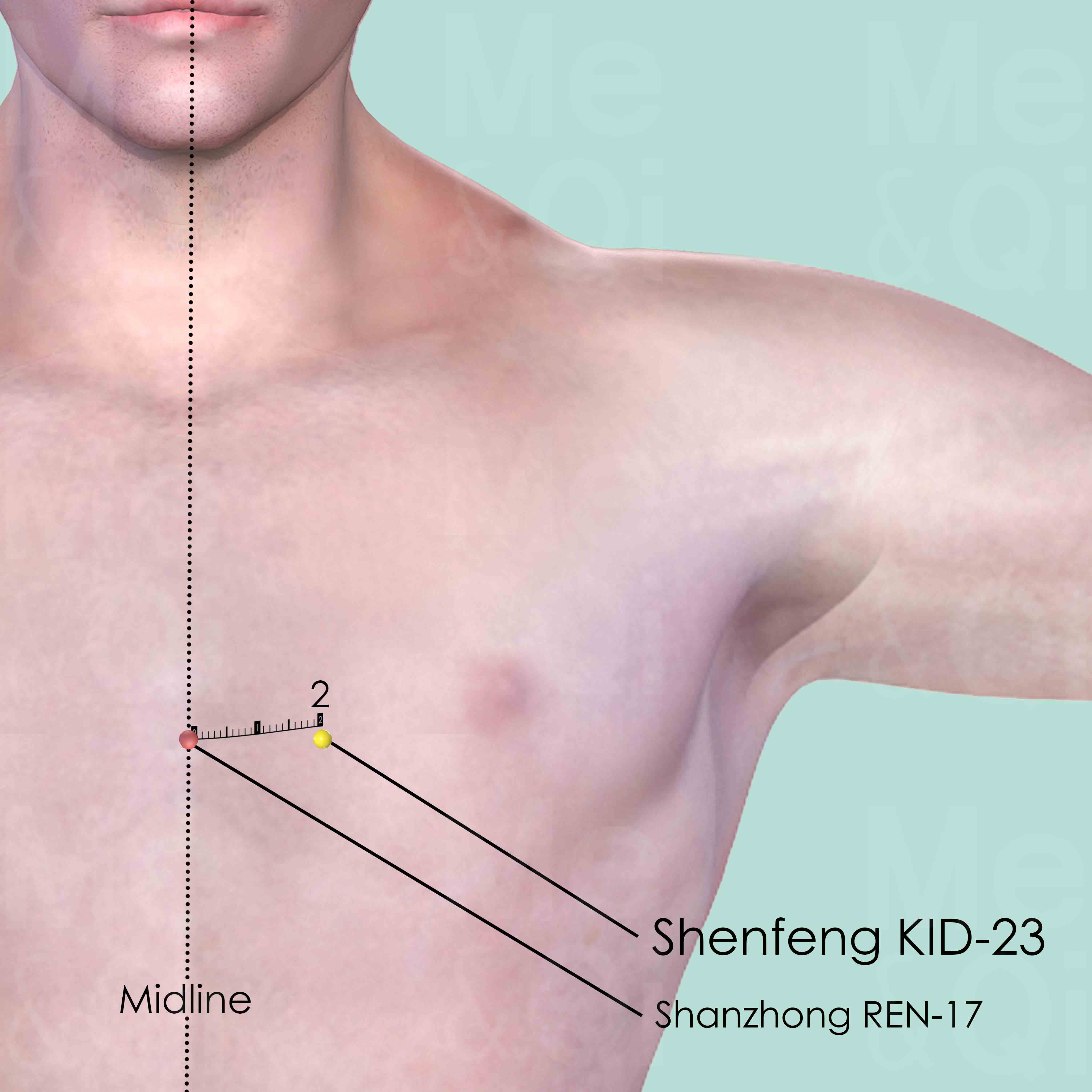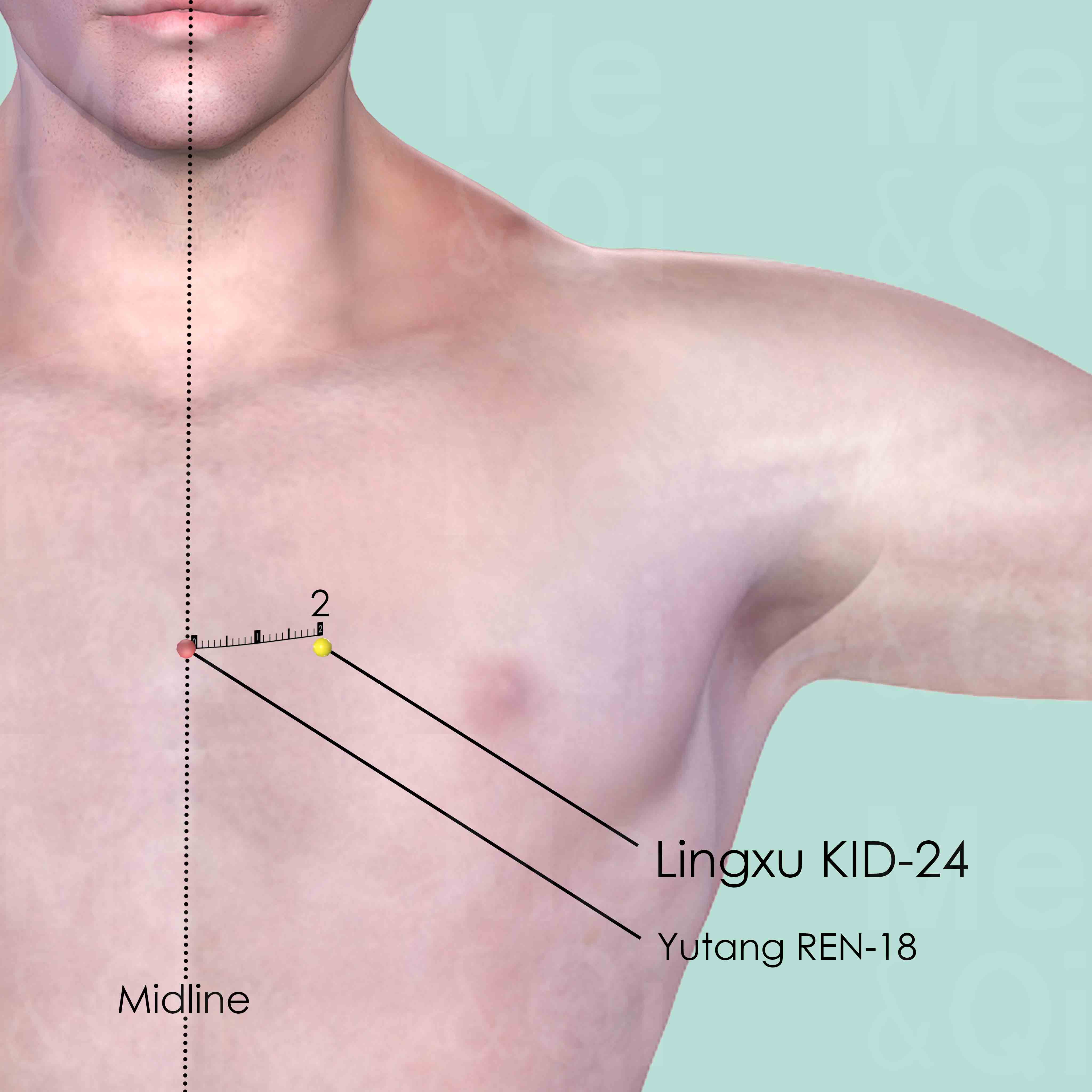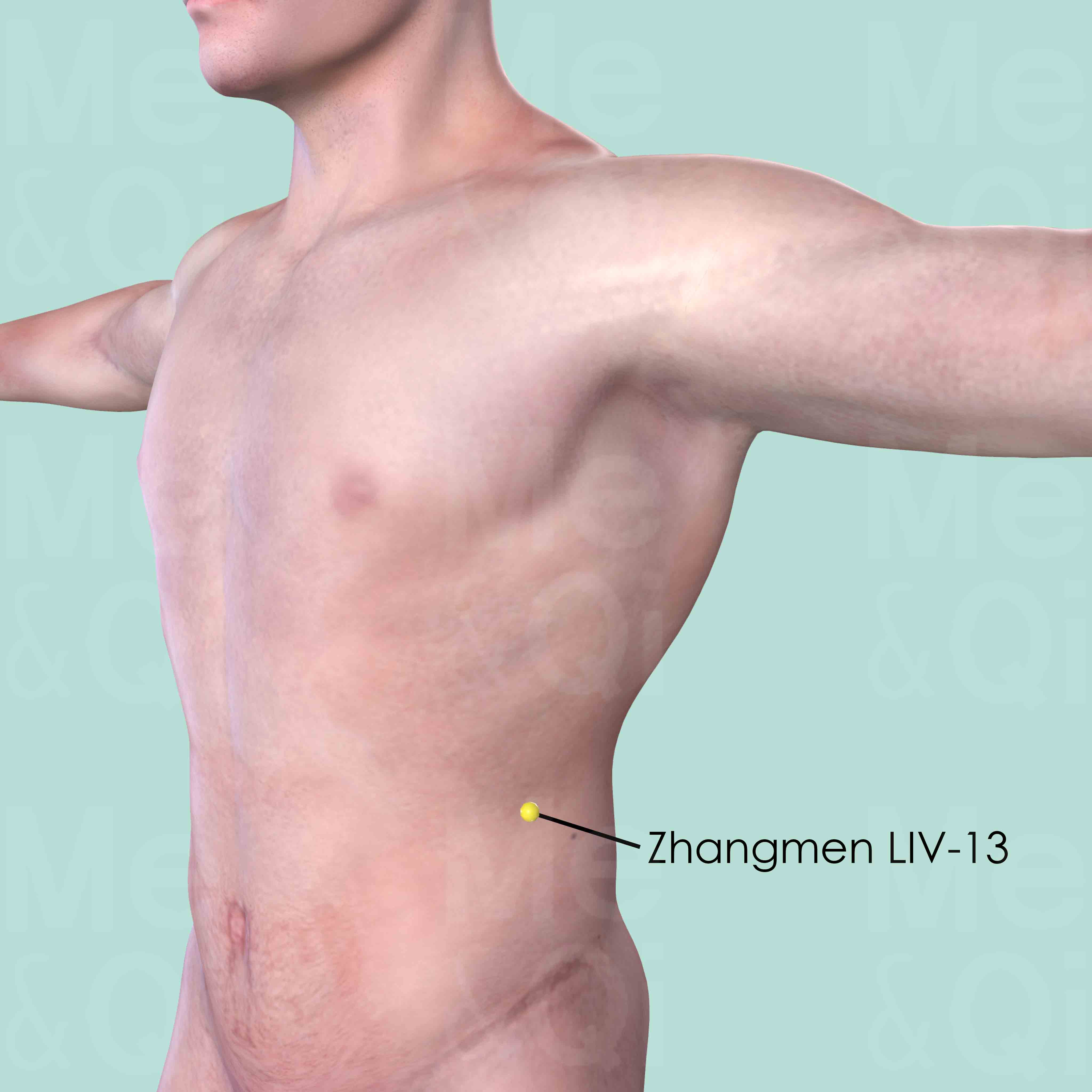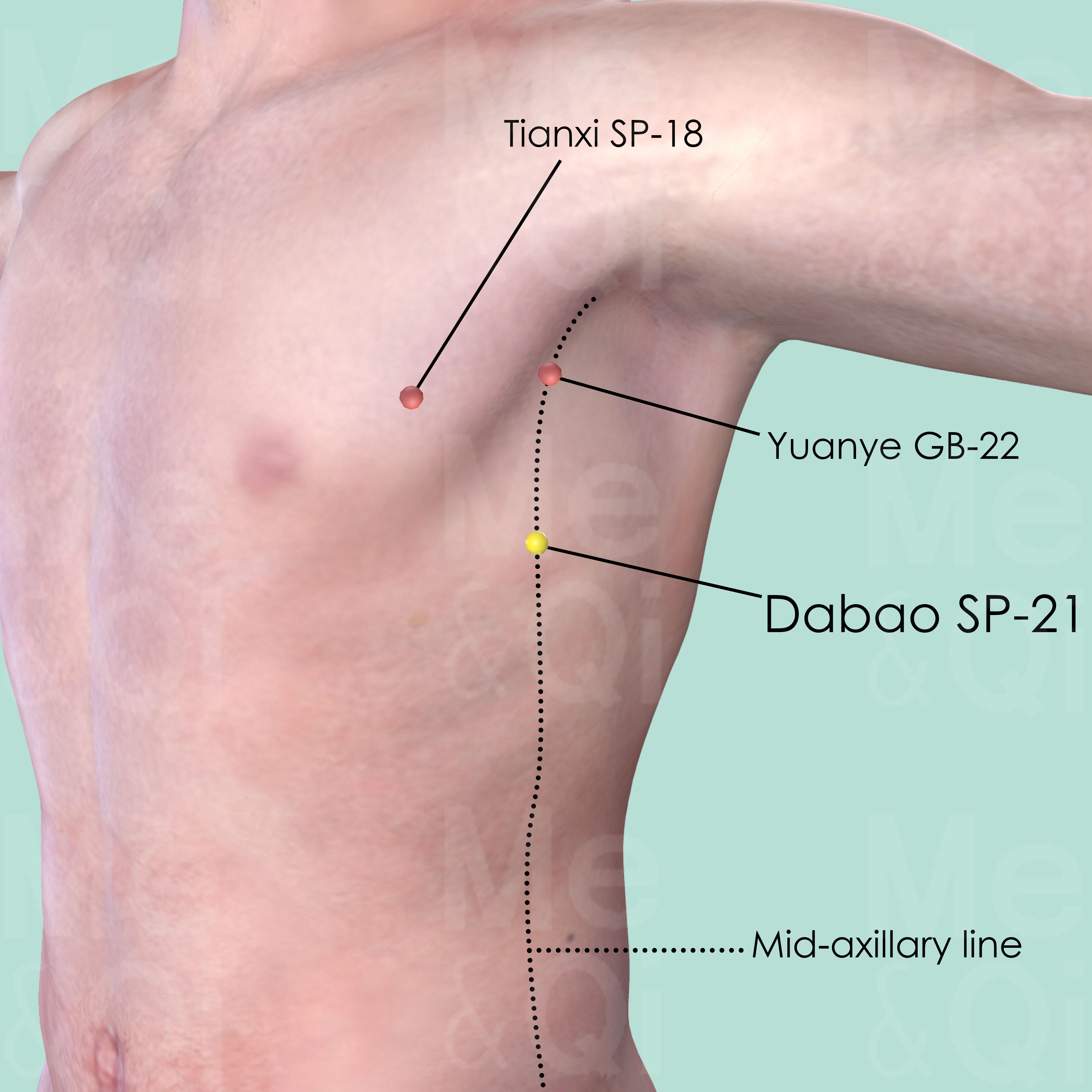Hypochondriac Distentionaccording to TCM
Root Causes of Hypochondriac Distention in TCM
Explore below more details about what might cause Hypochondriac distention according to TCM.
- By Syndrome
- By Organ
- Qi Stagnation
- Heat
- Qi Rebellion
- Dampness
- Phlegm
- Qi Deficiency
- Cold
- View More Causes
- Liver
- Gallbladder
- Spleen
- Stomach
- View More Organs
Qi Stagnation
Qi Stagnation in TCM is like having a traffic jam in your body's energy system. Qi, the vital life force that flows through your body, is supposed to move smoothly to maintain health and balance. But with Qi Stagnation, this flow gets blocked or slowed down, like cars stuck on a highway. This can lead to symptoms like feeling stressed, emotional mood swings, and physical discomfort, often described as a feeling of fullness or tightness, especially in the chest or abdomen. It's as though the body's internal energy circulation is disrupted, causing various issues. TCM sees this as an energy flow problem, different from modern medicine's focus on specific physiological processes.... see more
Qi Stagnation Patterns That Can Lead to Hypochondriac Distention
Common Symptoms: Upper Abdominal Distension Irritability Melancholia Depression Mood Swings Irregular Periods Globus Sensation Pre Menstrual Breast Distension
| Pattern Name | Relevant Symptoms | Relevant Formulas |
|---|---|---|
| Liver Qi Stagnation | HypochondriaI distension, Hypochondriac distention, Chest distension, Upper abdominal distension, Abdominal distention, Sighing, Melancholia, Depression, Mood swings, Irregular periods, Globus sensation, Pre menstrual breast distension, Pre menstrual tension, Anxiety, Anger... see more | Xiao Yao San | Jia Wei Xiao Yao San | Yue Ju Wan | Chai Hu Shu Gan San | Yi Guan Jian | Xia Ru Yong Quan San |
| Obstruction Of the Spleen By Dampness with Liver Qi Stagnation | Hypochondrial distention, Upper abdominal oppression, Nausea, Lack of appetite, Diarrhea, Feeling of heaviness, Dry mouth without desire to drink, Dull shallow face, Irritability, Upper abdominal distension, Hypochondriac distention, Hypochondriac pain... see more | Ping Wei San | Dang Gui Shao Yao San |
| Stagnant Liver Qi turning into Fire | Hypochondrial distention, Hypochondriac distention, Upper abdominal distension, Feeling of oppression of the chest, Irritability, Melancholia, Depression, Mood swings, Globus sensation, Feeling hot, Flushed face, Thirst, Anger, Pre menstrual tension, Irregular periods, Pre menstrual breast distension, Excessive menstruation... see more | Dan Zhi Xiao Yao San |
Heat
In TCM "Heat" signifies an excess of Yang energy, leading to an imbalance where heat predominates over the body's cool Yin aspects. This condition is metaphorically akin to an internal over-heating. Symptoms indicative of Heat can include feelings of warmth, fever, sweating, irritability, red face, thirst with a preference for cold drinks, and a rapid pulse. The tongue may appear red with a yellow coating. Unlike the common interpretation of heat in terms of temperature, in TCM, it represents a state of hyperactivity or inflammation in the body.... see more
Heat Patterns That Can Lead to Hypochondriac Distention
Common Symptoms: Irritability Hypochondriac Pain Scanty And Dark Urine Dry Mouth Without Desire To Drink Bitter Taste In The Mouth Dizziness Feeling Of Heaviness Upper Abdominal Distension
| Pattern Name | Relevant Symptoms | Relevant Formulas |
|---|---|---|
| Damp-Heat in the Gallbladder | Hypochondrial distention, Hypochondriac pain, Hypochondriac distention, Nausea or vomiting, Fat malabsorption, Dull yellow complexion, Scanty and dark urine, Fever, Dry mouth without desire to drink, Bitter taste in the mouth, Dizziness, Tinnitus, Irritability, Feeling of heaviness, Limb numbness, Foot edema, Alternating diarrhea and constipation, Alternating sensation of hot and cold, Yellow sclera... see more | Yin Chen Hao Tang |
| Obstruction Of the Spleen By Dampness with Liver Qi Stagnation | Hypochondrial distention, Upper abdominal oppression, Nausea, Lack of appetite, Diarrhea, Feeling of heaviness, Dry mouth without desire to drink, Dull shallow face, Irritability, Upper abdominal distension, Hypochondriac distention, Hypochondriac pain... see more | Ping Wei San | Dang Gui Shao Yao San |
| Stagnant Liver Qi turning into Fire | Hypochondrial distention, Hypochondriac distention, Upper abdominal distension, Feeling of oppression of the chest, Irritability, Melancholia, Depression, Mood swings, Globus sensation, Feeling hot, Flushed face, Thirst, Anger, Pre menstrual tension, Irregular periods, Pre menstrual breast distension, Excessive menstruation... see more | Dan Zhi Xiao Yao San |
Qi Rebellion
Rebellious Qi in TCM is a bit like having a rebel inside your body. Qi, which is the vital energy flowing through your body, is supposed to move in certain directions to keep everything in balance and working well. But with Rebellious Qi, this energy decides to go the opposite way. Think of it like a river flowing upstream instead of downstream. This can cause various issues like heartburn, coughing, or even headaches. It's as if the body's natural flow is disrupted, creating a kind of internal chaos. TCM focuses on correcting this flow, restoring order and balance.... see more
Qi Rebellion Patterns That Can Lead to Hypochondriac Distention
Common Symptoms: Upper Abdominal Distension Hiccups Sighing Nausea Or Vomiting Belching Irritability Stomach Churning Breast Engorgement
| Pattern Name | Relevant Symptoms | Relevant Formulas |
|---|---|---|
| Rebellious Liver Qi | Hypochondrial distention, Hypochondriac distention, Upper abdominal distension, Hiccups, Sighing, Nausea or vomiting, Belching, Stomach churning, Irritability, Breast engorgement, Headaches, Dizziness... see more | Chai Hu Shu Gan San | Si Ni San |
| Rebellious Liver Qi invading the Stomach | Hypochondrial distention, Irritability, Upper abdominal pain, Upper abdominal distension, Hypochondriac pain, Hypochondriac distention, Upper abdominal oppression, Acid reflux, Hiccups, Belching, Nausea or vomiting, Sighing, Weak limbs... see more | Xuan Fu Dai Zhe Tang | Ban Xia Hou Pu Tang | Si Mo Tang | Ju Pi Zhu Ru Tang | Ding Xiang Shi Di Tang |
Dampness
"Dampness" in TCM is a concept that describes a pattern of disharmony where the body accumulates excess moisture. Imagine the heavy, sticky feeling you get on a very humid day; that's similar to what dampness feels like internally. It can manifest as a sense of heaviness, bloating, sluggishness, or even a foggy mind. This condition is often thought to arise from environmental factors like living in a damp place, dietary habits that promote moisture in the body, or internal imbalances that hinder the body's ability to process fluids properly. In TCM, dampness can obstruct the normal flow of energy and fluids in the body, leading to various symptoms.... see more
Dampness Patterns That Can Lead to Hypochondriac Distention
Common Symptoms: Hypochondriac Pain Dry Mouth Without Desire To Drink Irritability Feeling Of Heaviness Nausea Or Vomiting Fat Malabsorption Dull Yellow Complexion Scanty And Dark Urine
| Pattern Name | Relevant Symptoms | Relevant Formulas |
|---|---|---|
| Damp-Heat in the Gallbladder | Hypochondrial distention, Hypochondriac pain, Hypochondriac distention, Nausea or vomiting, Fat malabsorption, Dull yellow complexion, Scanty and dark urine, Fever, Dry mouth without desire to drink, Bitter taste in the mouth, Dizziness, Tinnitus, Irritability, Feeling of heaviness, Limb numbness, Foot edema, Alternating diarrhea and constipation, Alternating sensation of hot and cold, Yellow sclera... see more | Yin Chen Hao Tang |
| Obstruction Of the Spleen By Dampness with Liver Qi Stagnation | Hypochondrial distention, Upper abdominal oppression, Nausea, Lack of appetite, Diarrhea, Feeling of heaviness, Dry mouth without desire to drink, Dull shallow face, Irritability, Upper abdominal distension, Hypochondriac distention, Hypochondriac pain... see more | Ping Wei San | Dang Gui Shao Yao San |
Phlegm
In TCM "Phlegm" as a pattern of disharmony is a complex concept that extends beyond the physical manifestation of mucus. It represents a pathological factor that can disrupt the flow of Qi (vital energy) and blood, leading to various health issues. Phlegm in TCM is seen as a sticky, turbid substance arising from the body's inability to metabolize fluids properly, often due to a dysfunction of the spleen. It's not only associated with respiratory problems like cough and congestion but also with systemic issues. Symptoms can include a feeling of heaviness, mental cloudiness, dizziness, and in some cases, the formation of lumps or masses. Phlegm can even be "invisible," contributing to emotional disturbances like depression or stress. ... see more
Phlegm Patterns That Can Lead to Hypochondriac Distention
| Pattern Name | Relevant Symptoms | Relevant Formulas |
|---|---|---|
| Phlegm-Fluids in the hypochondrium | HypochondriaI distension, Hypochondrial pain that is worse on coughing and breathing, Shortness of breath, Hypochondriac distention... see more | Shi Zao Tang |
Qi Deficiency
Qi Deficiency in TCM is like running low on battery power. Qi is the vital energy that powers every function in your body. When there's a Qi Deficiency, it means your body doesn't have enough of this essential energy. This can make you feel tired all the time, weak, or even cause shortness of breath. It's similar to how you feel when you haven't had enough sleep or nutritious food. Your body just doesn't have the energy it needs to perform at its best. Unlike modern medicine, which often focuses on specific physical causes for fatigue and weakness, TCM views Qi Deficiency as an overall energy depletion that affects your entire well-being, and it seeks to replenish and balance this vital energy.... see more
Qi Deficiency Patterns That Can Lead to Hypochondriac Distention
| Pattern Name | Relevant Symptoms | Relevant Formulas |
|---|---|---|
| Liver Qi Deficiency | Hypochondrial distention, Dizziness, Blurry vision, Eye floaters, Nervousness, Timidity, Easily startled, Lack of bravery, Indecision, Sighing, Vivid dreaming, Depression, Irritability, Hypochondriac distention, Irregular periods, Lack of appetite, Generalized fatigue, Abdominal distention... see more | Xiao Yao San | Bu Zhong Yi Qi Tang | Si Wu Tang |
Cold
In TCM "Cold" as a pattern of disharmony refers to a specific type of imbalance within the body's systems, often linked to a deficiency or weakness. It's not about feeling physically cold or having a common cold, but rather a metaphorical description of certain symptoms and underlying conditions. When a TCM practitioner says someone suffers from "Cold," it usually implies that the body's Yang energy, which is warm and active, is insufficient or overpowered by Yin energy, which is cool and passive. Symptoms of Cold in TCM can include a general feeling of coldness, cold limbs, pale complexion, low energy, slow metabolism, and a preference for warmth. ... see more
Cold Patterns That Can Lead to Hypochondriac Distention
| Pattern Name | Relevant Symptoms | Relevant Formulas |
|---|---|---|
| Stagnation of Cold in the Liver Channel | Hypochondrial fullness and distention with pain alleviated by warmth, Hypochondrial fullness with warmth relief, Testicular pain, Scrotal contraction, Vertical headaches, Chills, Cold extremities, Vomiting clear liquid, Vaginal atrophy... see more | Nuan Gan Jian |
Liver
In TCM the Liver is viewed as the organ responsible for the smooth flow of Qi, Blood, and emotions throughout the body. It plays a key role in regulating mood, storing blood, supporting digestion, and ensuring the health of tendons and eyes. When the Liver malfunctions or is imbalanced in TCM, it can lead to a range of issues such as irritability, mood swings, menstrual irregularities, eye problems, and muscular stiffness or pain. A malfunctioning Liver in TCM reflects not only physical disturbances but also emotional and mental disharmony, emphasizing the holistic approach of TCM in addressing health and wellness.... see more
Liver Patterns That Can Lead to Hypochondriac Distention
Common Symptoms: Irritability Upper Abdominal Distension Sighing Depression Irregular Periods Hiccups Hypochondriac Pain Lack Of Appetite
| Pattern Name | Relevant Symptoms | Relevant Formulas |
|---|---|---|
| Liver Qi Stagnation | HypochondriaI distension, Hypochondriac distention, Chest distension, Upper abdominal distension, Abdominal distention, Sighing, Melancholia, Depression, Mood swings, Irregular periods, Globus sensation, Pre menstrual breast distension, Pre menstrual tension, Anxiety, Anger... see more | Xiao Yao San | Jia Wei Xiao Yao San | Yue Ju Wan | Chai Hu Shu Gan San | Yi Guan Jian | Xia Ru Yong Quan San |
| Stagnation of Cold in the Liver Channel | Hypochondrial fullness and distention with pain alleviated by warmth, Hypochondrial fullness with warmth relief, Testicular pain, Scrotal contraction, Vertical headaches, Chills, Cold extremities, Vomiting clear liquid, Vaginal atrophy... see more | Nuan Gan Jian |
| Liver Qi Deficiency | Hypochondrial distention, Dizziness, Blurry vision, Eye floaters, Nervousness, Timidity, Easily startled, Lack of bravery, Indecision, Sighing, Vivid dreaming, Depression, Irritability, Hypochondriac distention, Irregular periods, Lack of appetite, Generalized fatigue, Abdominal distention... see more | Xiao Yao San | Bu Zhong Yi Qi Tang | Si Wu Tang |
| Obstruction Of the Spleen By Dampness with Liver Qi Stagnation | Hypochondrial distention, Upper abdominal oppression, Nausea, Lack of appetite, Diarrhea, Feeling of heaviness, Dry mouth without desire to drink, Dull shallow face, Irritability, Upper abdominal distension, Hypochondriac distention, Hypochondriac pain... see more | Ping Wei San | Dang Gui Shao Yao San |
| Rebellious Liver Qi | Hypochondrial distention, Hypochondriac distention, Upper abdominal distension, Hiccups, Sighing, Nausea or vomiting, Belching, Stomach churning, Irritability, Breast engorgement, Headaches, Dizziness... see more | Chai Hu Shu Gan San | Si Ni San |
| Rebellious Liver Qi invading the Stomach | Hypochondrial distention, Irritability, Upper abdominal pain, Upper abdominal distension, Hypochondriac pain, Hypochondriac distention, Upper abdominal oppression, Acid reflux, Hiccups, Belching, Nausea or vomiting, Sighing, Weak limbs... see more | Xuan Fu Dai Zhe Tang | Ban Xia Hou Pu Tang | Si Mo Tang | Ju Pi Zhu Ru Tang | Ding Xiang Shi Di Tang |
| Stagnant Liver Qi turning into Fire | Hypochondrial distention, Hypochondriac distention, Upper abdominal distension, Feeling of oppression of the chest, Irritability, Melancholia, Depression, Mood swings, Globus sensation, Feeling hot, Flushed face, Thirst, Anger, Pre menstrual tension, Irregular periods, Pre menstrual breast distension, Excessive menstruation... see more | Dan Zhi Xiao Yao San |
Gallbladder
In TCM the Gallbladder has a unique role in storing and excreting bile, but more importantly, it's seen as crucial for decision-making and courage. It's closely connected to the Liver, assisting in the smooth flow of Qi (vital energy) and supporting the Liver's role in maintaining emotional balance. When the Gallbladder malfunctions or is imbalanced in TCM, it can lead to physical symptoms like gallstones, jaundice, or a bitter taste in the mouth. There might also be digestive disturbances, particularly related to fat metabolism. On an emotional level, a Gallbladder disorder can manifest as indecisiveness, timidity, or a tendency to easily succumb to stress. These symptoms highlight the TCM view of the Gallbladder as integral to both physical processes and emotional resilience.... see more
Gallbladder Patterns That Can Lead to Hypochondriac Distention
| Pattern Name | Relevant Symptoms | Relevant Formulas |
|---|---|---|
| Damp-Heat in the Gallbladder | Hypochondrial distention, Hypochondriac pain, Hypochondriac distention, Nausea or vomiting, Fat malabsorption, Dull yellow complexion, Scanty and dark urine, Fever, Dry mouth without desire to drink, Bitter taste in the mouth, Dizziness, Tinnitus, Irritability, Feeling of heaviness, Limb numbness, Foot edema, Alternating diarrhea and constipation, Alternating sensation of hot and cold, Yellow sclera... see more | Yin Chen Hao Tang |
Spleen
In TCM the Spleen plays a vital role in digestion and transformation, converting food into energy and nutrients, and overseeing the distribution of Qi and Blood. It's also crucial in maintaining the health of muscles and limbs and ensuring the blood remains within the vessels. When the Spleen malfunctions in TCM, it can lead to a variety of issues such as digestive disorders, fatigue, weak muscles, bloating, and a feeling of heaviness. It can also cause a pale complexion, poor appetite, and a tendency to bruise easily. Emotionally, a Spleen imbalance is often associated with excessive worry or overthinking, reflecting its role in the interplay between physical and mental health.... see more
Spleen Patterns That Can Lead to Hypochondriac Distention
| Pattern Name | Relevant Symptoms | Relevant Formulas |
|---|---|---|
| Obstruction Of the Spleen By Dampness with Liver Qi Stagnation | Hypochondrial distention, Upper abdominal oppression, Nausea, Lack of appetite, Diarrhea, Feeling of heaviness, Dry mouth without desire to drink, Dull shallow face, Irritability, Upper abdominal distension, Hypochondriac distention, Hypochondriac pain... see more | Ping Wei San | Dang Gui Shao Yao San |
Stomach
In TCM the Stomach is regarded as the "sea of nourishment," pivotal for digesting food and transforming it into Qi and blood. It works closely with the Spleen to distribute these essential nutrients throughout the body. When the Stomach is out of balance or malfunctions in TCM, it often leads to digestive problems such as bloating, nausea, vomiting, poor appetite, or a feeling of fullness. There may also be issues like acid reflux or a sour taste in the mouth. Emotionally, an imbalanced Stomach can contribute to excessive worry and overthinking, reflecting the TCM belief that physical and emotional well-being are deeply interconnected.... see more
Stomach Patterns That Can Lead to Hypochondriac Distention
| Pattern Name | Relevant Symptoms | Relevant Formulas |
|---|---|---|
| Rebellious Liver Qi invading the Stomach | Hypochondrial distention, Irritability, Upper abdominal pain, Upper abdominal distension, Hypochondriac pain, Hypochondriac distention, Upper abdominal oppression, Acid reflux, Hiccups, Belching, Nausea or vomiting, Sighing, Weak limbs... see more | Xuan Fu Dai Zhe Tang | Ban Xia Hou Pu Tang | Si Mo Tang | Ju Pi Zhu Ru Tang | Ding Xiang Shi Di Tang |
TCM Herbal Formulas for Hypochondriac Distention
Explore below some TCM herbal formulas used to address hypochondriac distention, organized by cause and by formula type.
- By Cause
- By Formula Type
- Qi Stagnation
- Heat
- Qi Rebellion
- Dampness
- Phlegm
- Qi Deficiency
- Cold
- View More Causes
- Formulas that promote qi movement
- Formulas that harmonize liver-Spleen
- Formulas for a rebellious qi
- Formulas that invigorate blood and dispel blood stagnation
- Formulas that nourish yin and tonify
- Formulas that drive out excess water
- Formulas that clear heat and expel dampness
- Formulas that harmonize lesser yang-warp disorders
- Formulas that tonify qi
- Formulas that tonify blood
- Formulas that transform dampness and harmonize stomach
- Formulas that clear liver-Heat
Top Formula for Qi Stagnation:
Xiao Yao San
Suitable for Qi Stagnation patterns that may cause hypochondriac distention, such as Liver Qi Stagnation
Learn moreAll Formulas Recommended for Hypochondriac Distention Caused by Qi Stagnation
| Formula | Patterns Suitable For |
|---|---|
| Xiao Yao San | Liver Qi Stagnation |
| Chai Hu Shu Gan San | Liver Qi Stagnation |
| Jia Wei Xiao Yao San | Liver Qi Stagnation |
| Yue Ju Wan | Liver Qi Stagnation |
| Yi Guan Jian | Liver Qi Stagnation |
| Xia Ru Yong Quan San | Liver Qi Stagnation |
| Ping Wei San | Obstruction Of the Spleen By Dampness with Liver Qi Stagnation |
| Dang Gui Shao Yao San | Obstruction Of the Spleen By Dampness with Liver Qi Stagnation |
| Dan Zhi Xiao Yao San | Stagnant Liver Qi turning into Fire |
Top Formula for Heat:
Yin Chen Hao Tang
Suitable for Heat patterns that may cause hypochondriac distention, such as Damp-Heat in the Gallbladder
Learn moreAll Formulas Recommended for Hypochondriac Distention Caused by Heat
| Formula | Patterns Suitable For |
|---|---|
| Yin Chen Hao Tang | Damp-Heat in the Gallbladder |
| Ping Wei San | Obstruction Of the Spleen By Dampness with Liver Qi Stagnation |
| Dang Gui Shao Yao San | Obstruction Of the Spleen By Dampness with Liver Qi Stagnation |
| Dan Zhi Xiao Yao San | Stagnant Liver Qi turning into Fire |
Top Formula for Qi Rebellion:
Chai Hu Shu Gan San
Suitable for Qi Rebellion patterns that may cause hypochondriac distention, such as Rebellious Liver Qi
Learn moreAll Formulas Recommended for Hypochondriac Distention Caused by Qi Rebellion
| Formula | Patterns Suitable For |
|---|---|
| Chai Hu Shu Gan San | Rebellious Liver Qi |
| Si Ni San | Rebellious Liver Qi |
| Xuan Fu Dai Zhe Tang | Rebellious Liver Qi invading the Stomach |
| Ban Xia Hou Pu Tang | Rebellious Liver Qi invading the Stomach |
| Si Mo Tang | Rebellious Liver Qi invading the Stomach |
| Ju Pi Zhu Ru Tang | Rebellious Liver Qi invading the Stomach |
| Ding Xiang Shi Di Tang | Rebellious Liver Qi invading the Stomach |
Top Formula for Dampness:
Yin Chen Hao Tang
Suitable for Dampness patterns that may cause hypochondriac distention, such as Damp-Heat in the Gallbladder
Learn moreAll Formulas Recommended for Hypochondriac Distention Caused by Dampness
| Formula | Patterns Suitable For |
|---|---|
| Yin Chen Hao Tang | Damp-Heat in the Gallbladder |
| Ping Wei San | Obstruction Of the Spleen By Dampness with Liver Qi Stagnation |
| Dang Gui Shao Yao San | Obstruction Of the Spleen By Dampness with Liver Qi Stagnation |
Top Formula for Phlegm:
Shi Zao Tang
Suitable for Phlegm patterns that may cause hypochondriac distention, such as Phlegm-Fluids in the hypochondrium
Learn moreTop Formula for Qi Deficiency:
Xiao Yao San
Suitable for Qi Deficiency patterns that may cause hypochondriac distention, such as Liver Qi Deficiency
Learn moreAll Formulas Recommended for Hypochondriac Distention Caused by Qi Deficiency
| Formula | Patterns Suitable For |
|---|---|
| Xiao Yao San | Liver Qi Deficiency |
| Bu Zhong Yi Qi Tang | Liver Qi Deficiency |
| Si Wu Tang | Liver Qi Deficiency |
Top Formula for Cold:
Nuan Gan Jian
Suitable for Cold patterns that may cause hypochondriac distention, such as Stagnation of Cold in the Liver Channel
Learn moreFormulas that promote Qi movement
These formulas are suitable for some hypochondriac distention-causing patterns like Liver Qi Stagnation or Rebellious Liver Qi.
One such formula is Chai Hu Shu Gan San, with bupleurum root as a key herb.
Other formulas of this category are listed in the table below.
All "formulas that promote qi movement" recommended for hypochondriac distention
| Formula | Patterns Suitable For (if applicable) |
|---|---|
| Chai Hu Shu Gan San | Liver Qi Stagnation, Rebellious Liver Qi |
| Yue Ju Wan | Liver Qi Stagnation |
| Nuan Gan Jian | Stagnation of Cold in the Liver Channel |
| Ban Xia Hou Pu Tang | Rebellious Liver Qi invading the Stomach |
| Si Mo Tang | Rebellious Liver Qi invading the Stomach |
Formulas that harmonize Liver-Spleen
These formulas are suitable for some hypochondriac distention-causing patterns like Liver Qi Stagnation or Liver Qi Deficiency.
One such formula is Xiao Yao San, with bupleurum root as a key herb.
Other formulas of this category are listed in the table below.
All "formulas that harmonize liver-Spleen" recommended for hypochondriac distention
| Formula | Patterns Suitable For (if applicable) |
|---|---|
| Xiao Yao San | Liver Qi Stagnation, Liver Qi Deficiency |
| Jia Wei Xiao Yao San | Liver Qi Stagnation |
| Si Ni San | Rebellious Liver Qi |
Formulas that invigorate Blood and dispel Blood Stagnation
These formulas are suitable for some hypochondriac distention-causing patterns like Liver Qi Stagnation.
One such formula is Xia Ru Yong Quan San, with dong quai as a key herb.
Other formulas of this category are listed in the table below.
All "formulas that invigorate blood and dispel blood stagnation" recommended for hypochondriac distention
| Formula | Patterns Suitable For (if applicable) |
|---|---|
| Xia Ru Yong Quan San | Liver Qi Stagnation |
| Dang Gui Shao Yao San | Obstruction Of the Spleen By Dampness with Liver Qi Stagnation |
Formulas for a rebellious Qi
These formulas are suitable for some hypochondriac distention-causing patterns like Rebellious Liver Qi invading the Stomach.
One such formula is Xuan Fu Dai Zhe Tang, with inula flower as a key herb.
Other formulas of this category are listed in the table below.
All "formulas for a rebellious qi" recommended for hypochondriac distention
| Formula | Patterns Suitable For (if applicable) |
|---|---|
| Xuan Fu Dai Zhe Tang | Rebellious Liver Qi invading the Stomach |
| Ju Pi Zhu Ru Tang | Rebellious Liver Qi invading the Stomach |
| Ding Xiang Shi Di Tang | Rebellious Liver Qi invading the Stomach |
Formulas that nourish Yin and tonify
These formulas are suitable for some hypochondriac distention-causing patterns like Liver Qi Stagnation.
One such formula is Yi Guan Jian
Formulas that drive out excess water
These formulas are suitable for some hypochondriac distention-causing patterns like Phlegm-Fluids in the hypochondrium.
One such formula is Shi Zao Tang, with kansui root as a key herb.
Formulas that clear Heat and expel dampness
These formulas are suitable for some hypochondriac distention-causing patterns like Damp-Heat in the Gallbladder.
One such formula is Yin Chen Hao Tang, with virgate wormwood as a key herb.
Formulas that harmonize lesser Yang-warp disorders
These formulas are suitable for some hypochondriac distention-causing patterns like Lesser Yang stage.
One such formula is Xiao Chai Hu Tang, with bupleurum root as a key herb.
Formulas that tonify Qi
These formulas are suitable for some hypochondriac distention-causing patterns like Liver Qi Deficiency.
One such formula is Bu Zhong Yi Qi Tang, with milkvetch root as a key herb.
Formulas that tonify Blood
These formulas are suitable for some hypochondriac distention-causing patterns like Liver Qi Deficiency.
One such formula is Si Wu Tang, with prepared rehmannia as a key herb.
Formulas that transform Dampness and harmonize Stomach
These formulas are suitable for some hypochondriac distention-causing patterns like Obstruction Of the Spleen By Dampness with Liver Qi Stagnation.
One such formula is Ping Wei San, with black atractylodes rhizome as a key herb.
Formulas that clear Liver-Heat
These formulas are suitable for some hypochondriac distention-causing patterns like Stagnant Liver Qi turning into Fire.
One such formula is Dan Zhi Xiao Yao San, with mudan peony bark as a key herb.
Acupoints for Hypochondriac Distention
Explore below some acupoints used to address hypochondriac distention, organized by meridian.
- By Meridian
- Gall Bladder Channel
- Kidney Channel
- Bladder Channel
- Liver Channel
- Pericardium Channel
- Spleen Channel
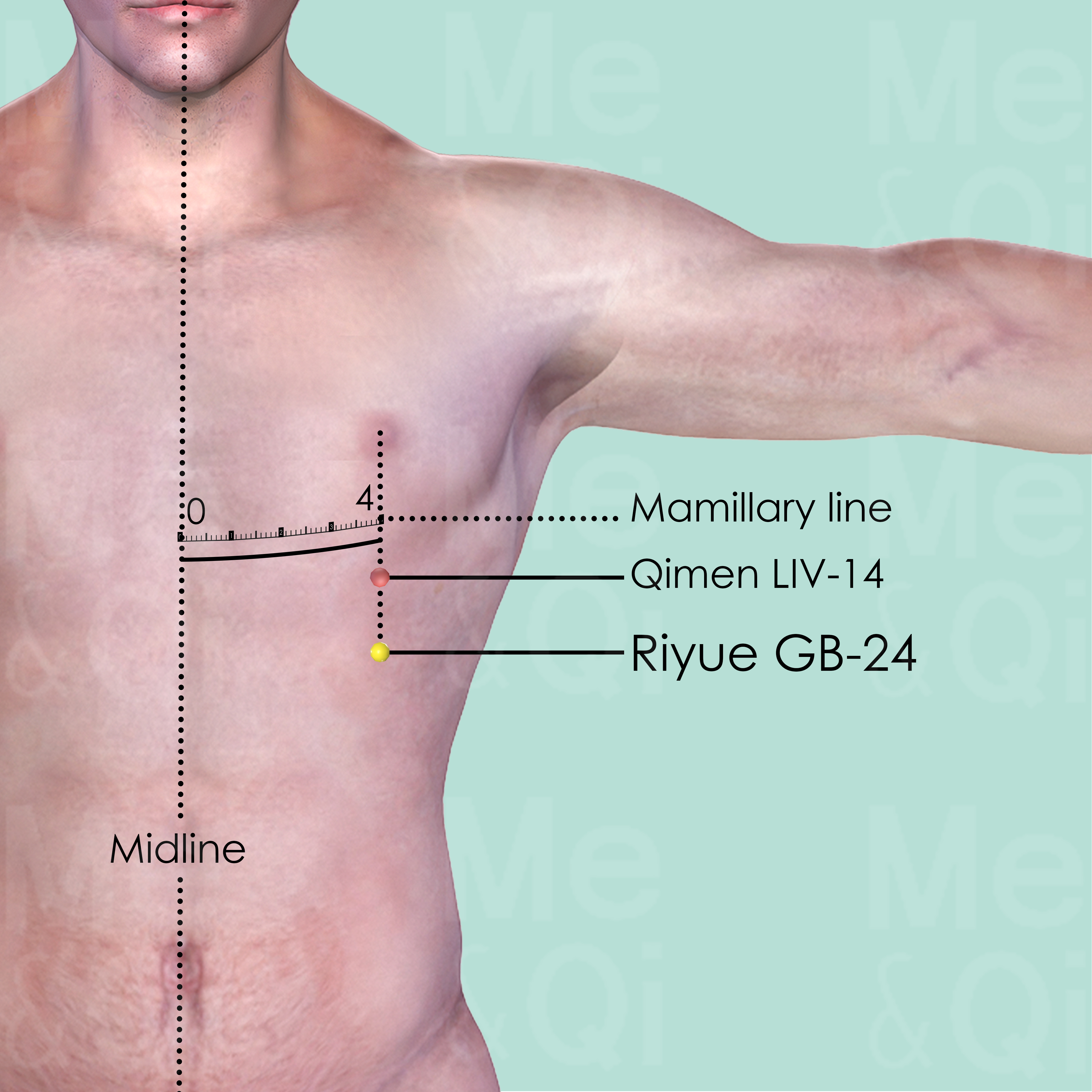
Riyue GB-24
On the mamillary line which is 4 cun lateral to the anterior midline, in the 7th intercostal space, 1 intercostal space below Qimen LIV-14.
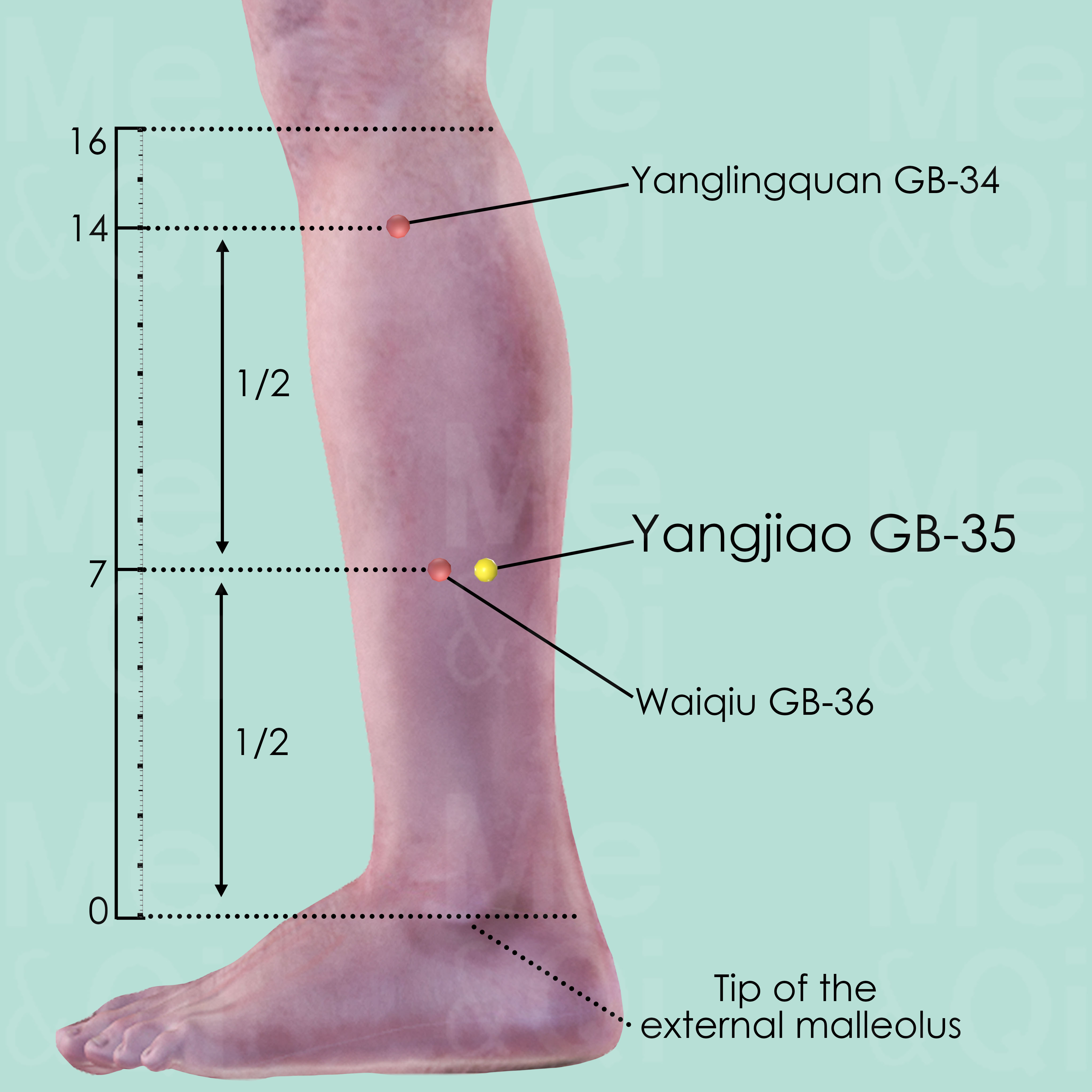
Yangjiao GB-35
7 cun above the tip of the external malleolus, on the posterior border of the fibula, within the distance between the tip of the external malleolus and Yanglingquan GB-34. It is also at the same level as Waiqiu GB-36.
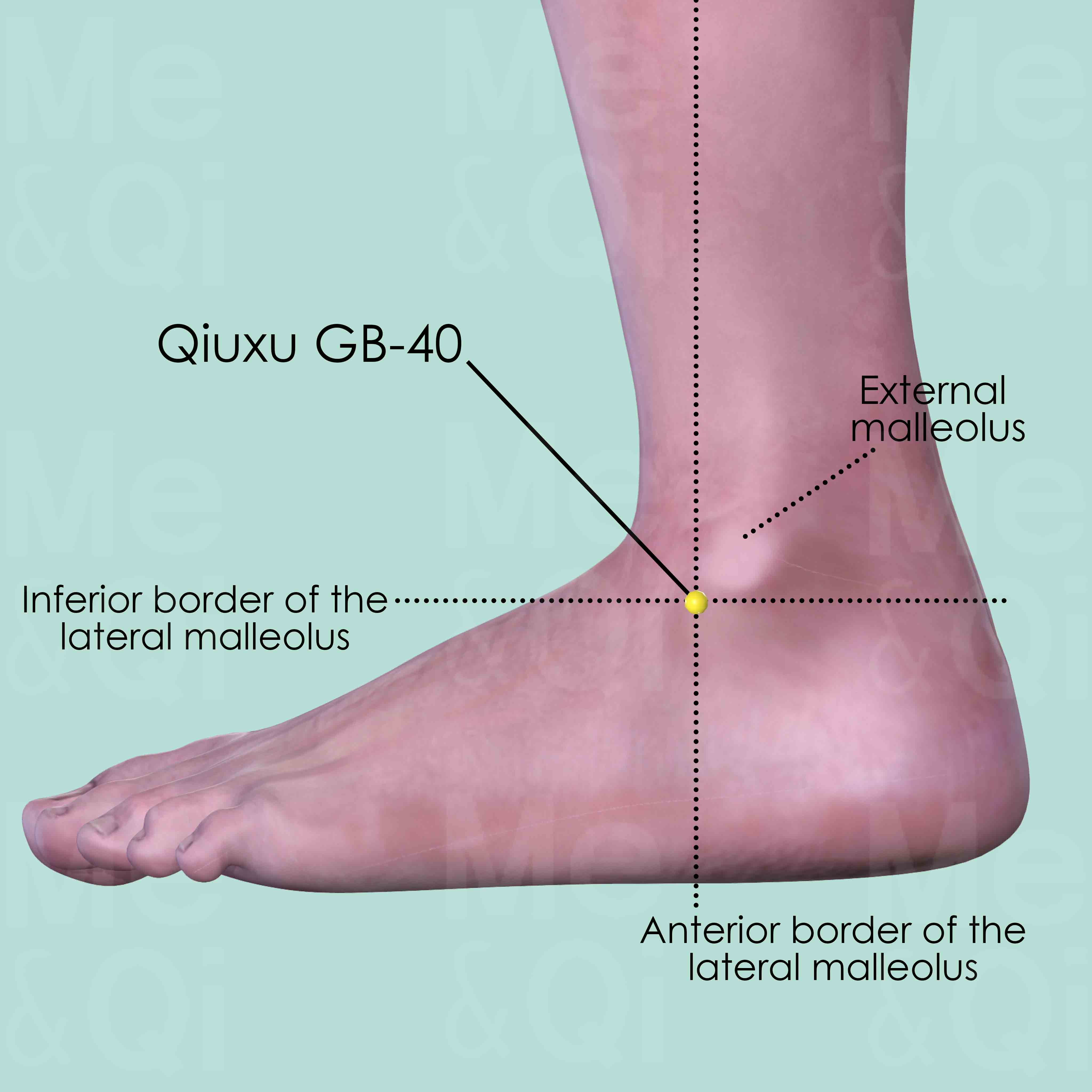
Qiuxu GB-40
Anterior and inferior to the external malleolus, in the depression on the lateral side of the tendon of extensor digitorum longus muscle that goes to the little toe.
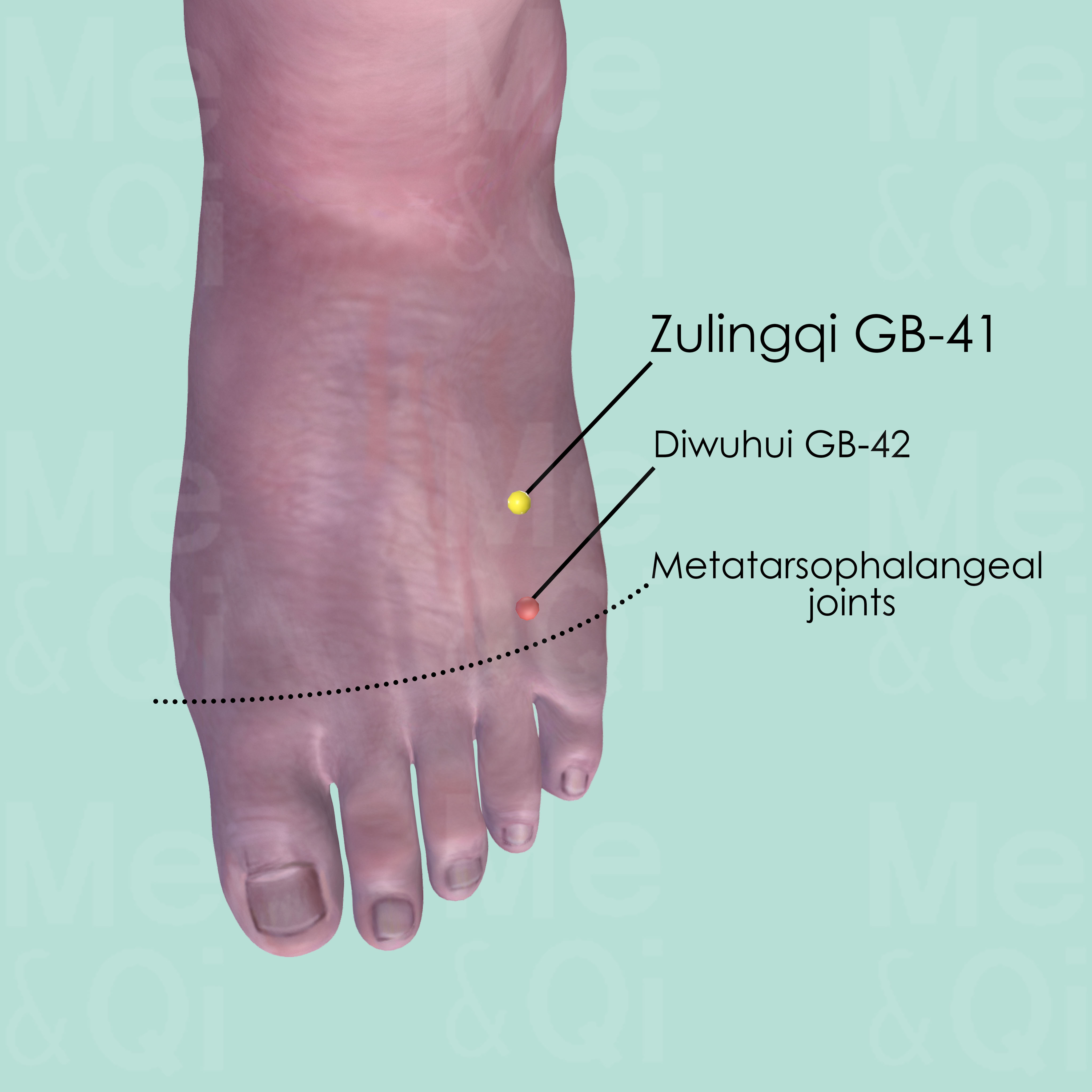
Zulingqi GB-41
In the depression distal to the junction of the 4th and 5th metatarsal bones, on the lateral side of the tendon of extensor digitorum longus muscle of the foot.
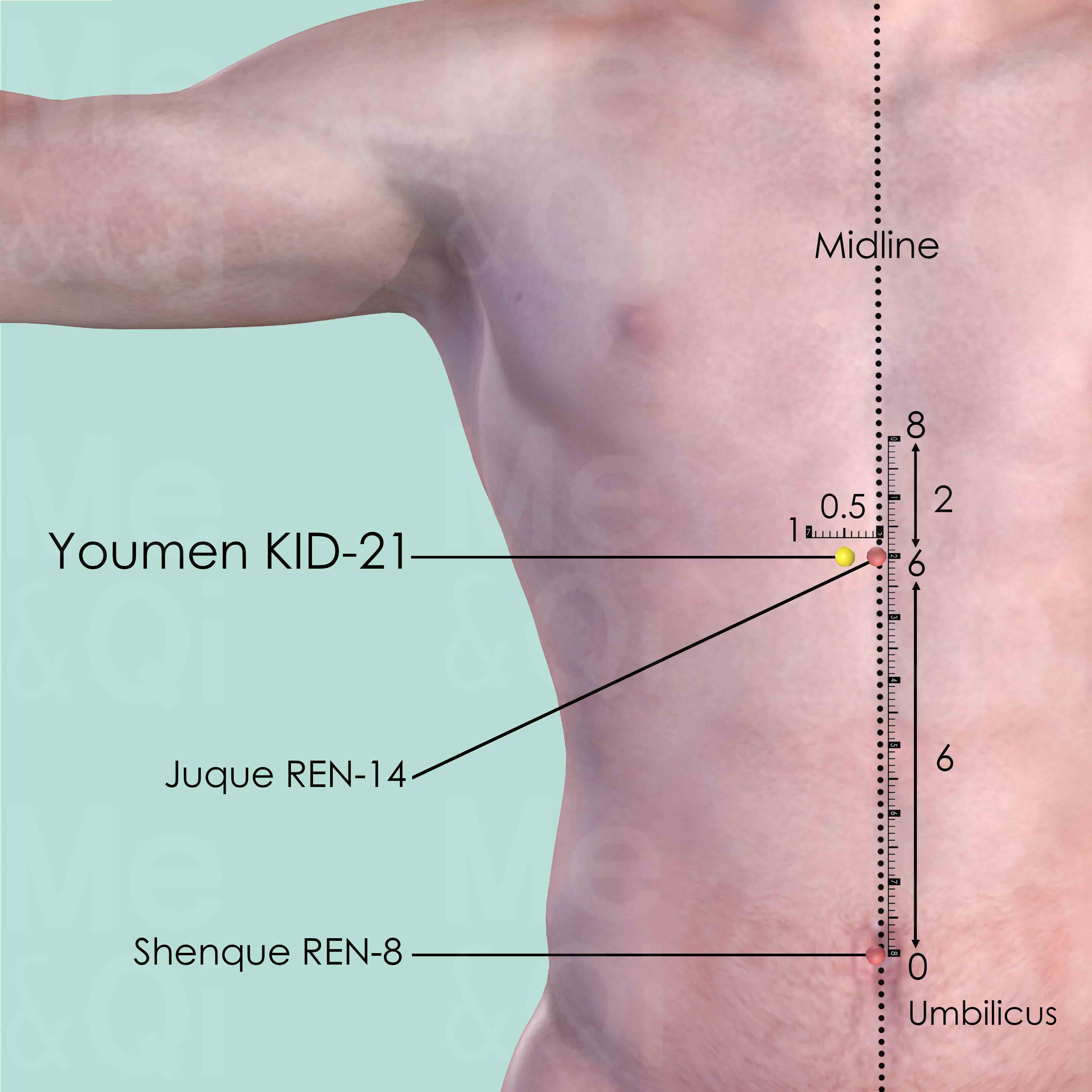
Youmen KID-21
6 cun above the umbilicus and 2 cun below the sternocostal angle, 0.5 cun lateral to the anterior midline.
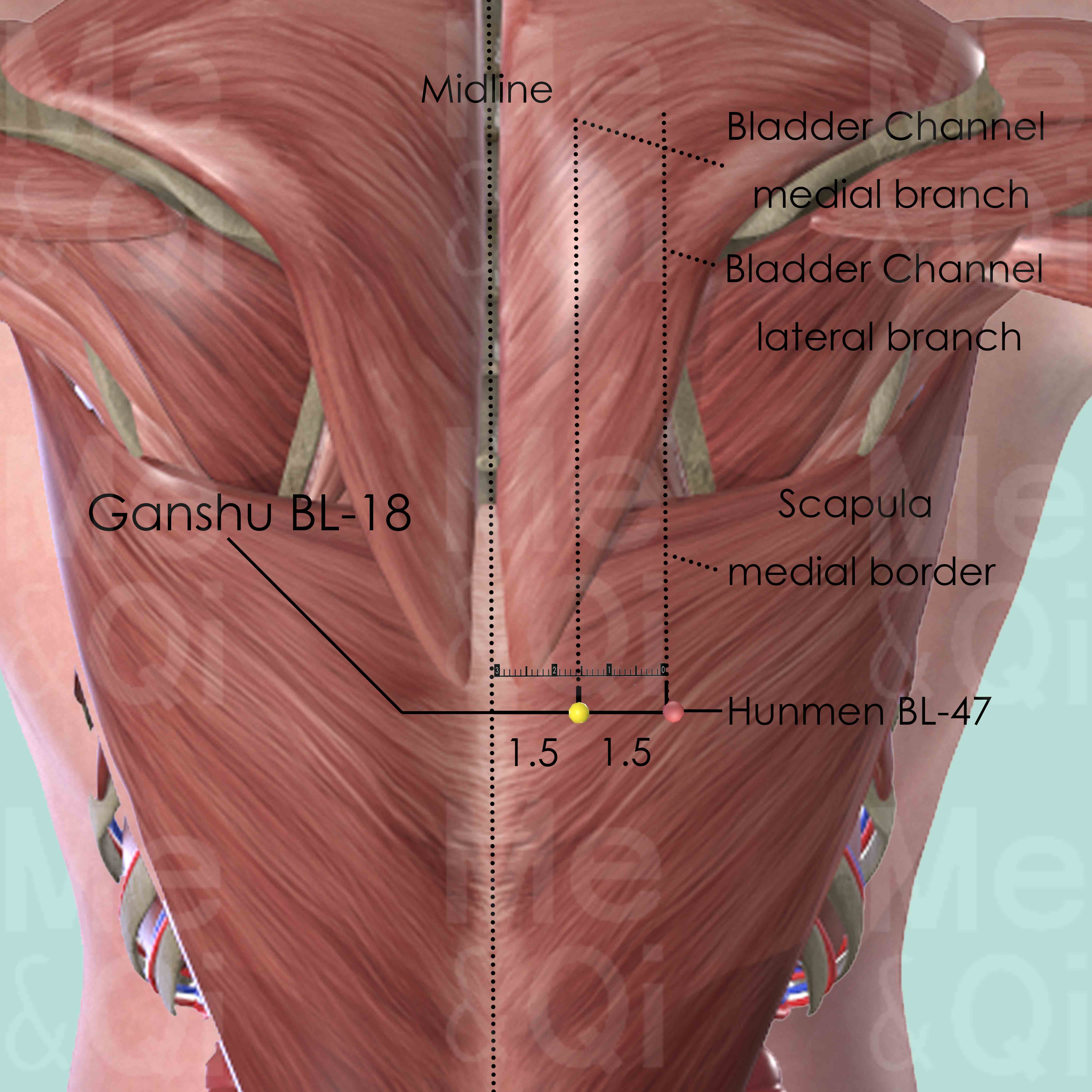
Ganshu BL-18
1.5 cun lateral to the lower border of the spinous process of the 9th thoracic vertebra (T9).
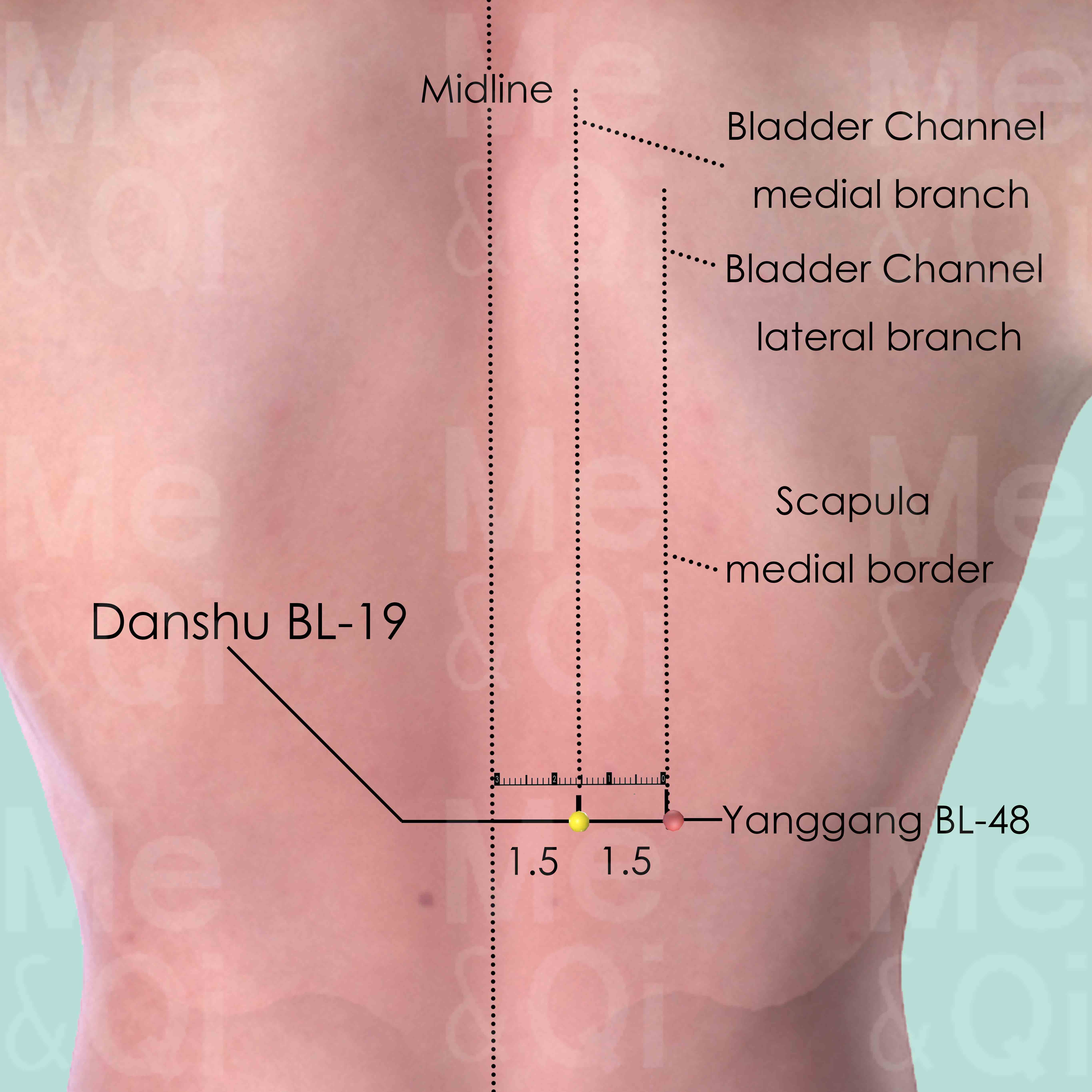
Danshu BL-19
1.5 cun lateral to the lower border of the spinous process of the 10th thoracic vertebra (T10).
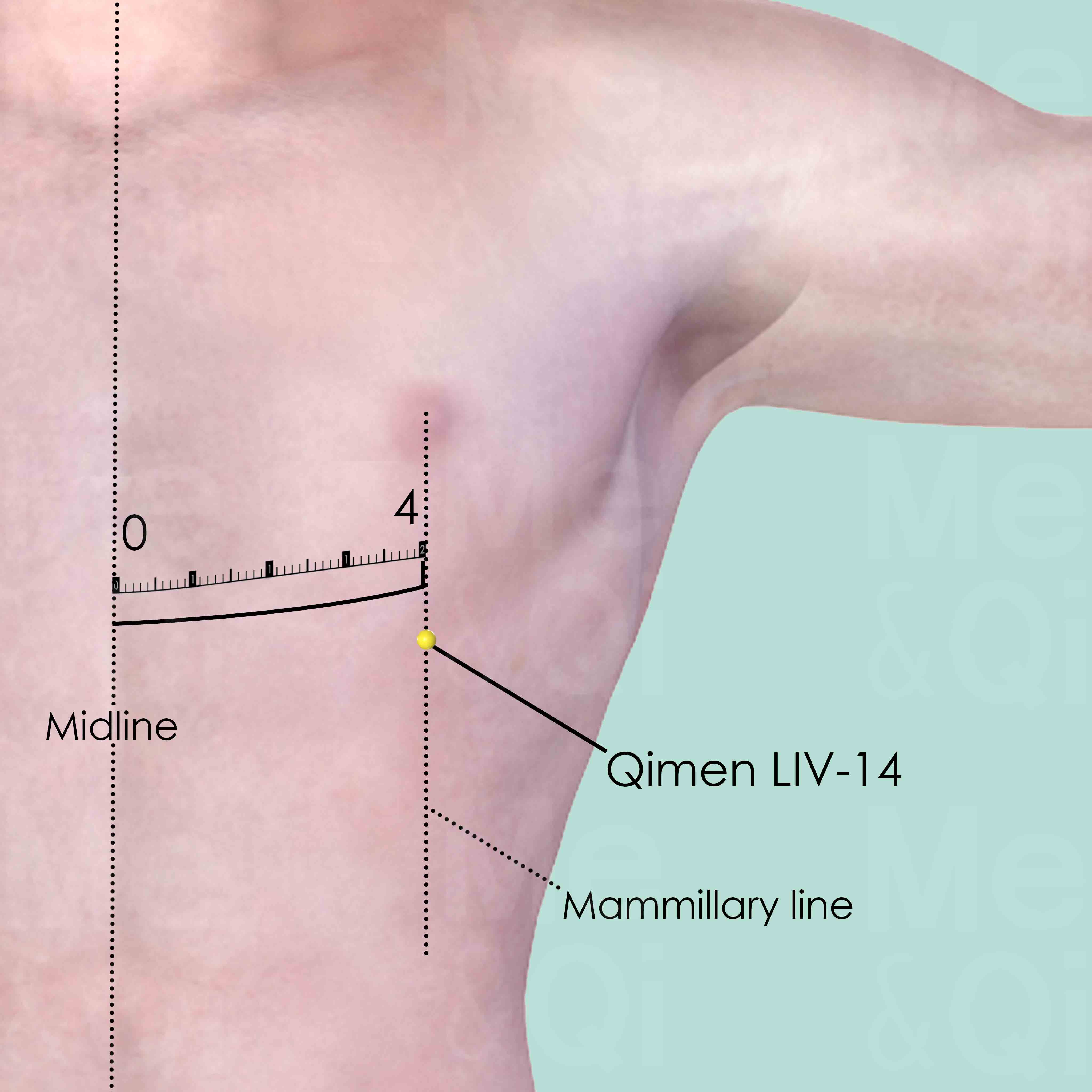
Qimen LIV-14
On the mammillary line, two ribs below the nipple, in the 6th intercostal space, 4 cun lateral to the midline. Please note that there is an alternative location for LIV-14 at the lower edge of the ribcage in line with the nipple or, in women, 4 cun from the midline. In fact, one could look upon these as two separate points. The one in the intercostal space is used more for Channel problems. While the one at the lower edge of the ribcage is used more for Organ problems.
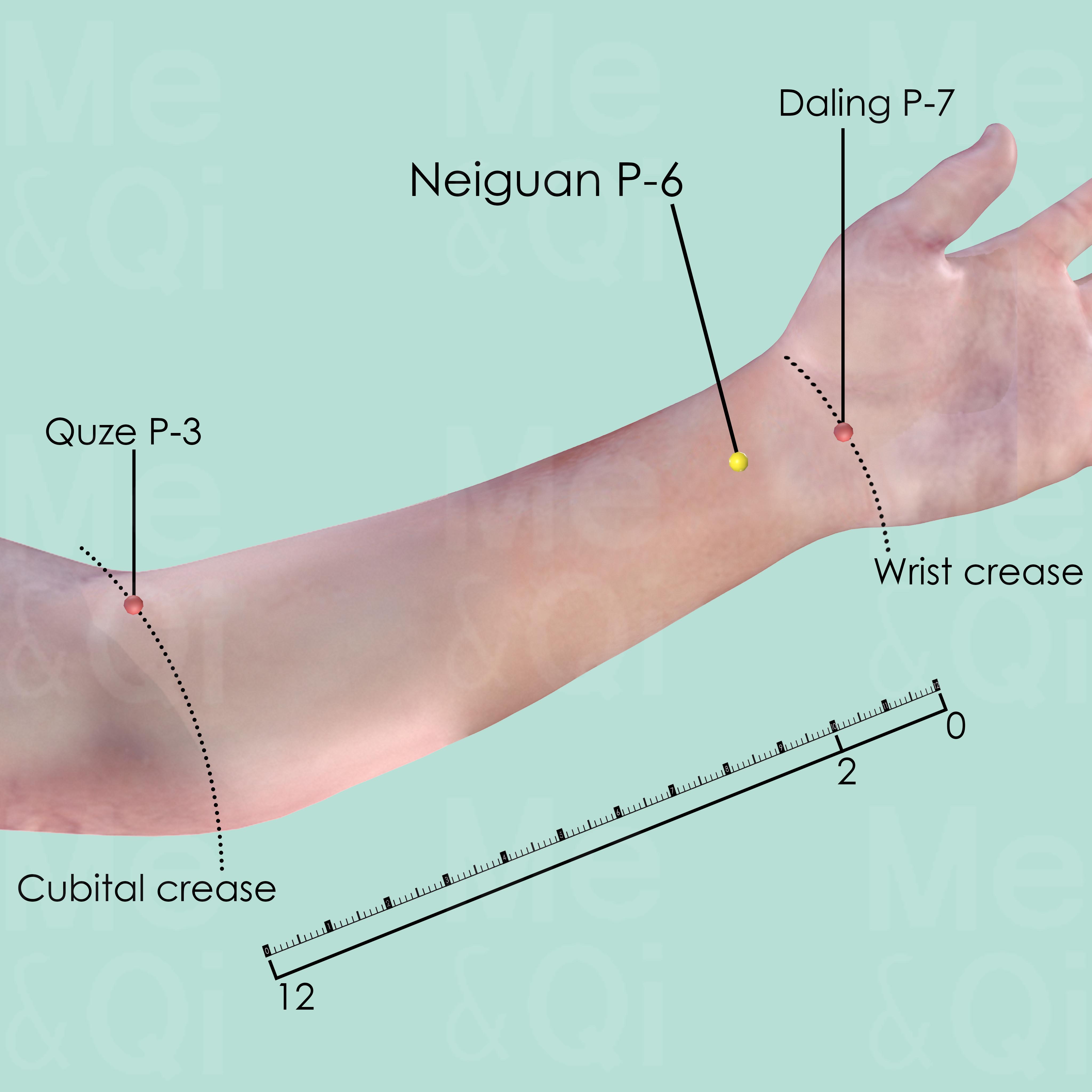
Neiguan P-6
2 cun above Daling P-7 on the transverse crease of the wrist, between the tendons of palmaris longus and flexor carpi radialis muscle.

